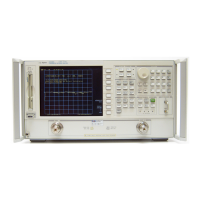7-112 Chapter7
Programming Examples
Report Generation Examples
The plot file name is made up of four parts. The first three are generated automatically by
the analyzer whenever a plot is requested:
1. the prefix “PLOT”
2. a two-digit sequence number in the range of 00 to 31
3. a two-letter output-format code to indicate the plot quadrant position:
• LU (Left Upper)
• LL (Left Lower)
• RU (Right Upper)
• RL (Right Lower)
• FP (Full Page)
For example, the first full page plot to a disk would be named “PLOT00FP.” The second
plot, to be located in the lower-right hand corner of the page would be named “PLOT01RL,”
and so on.
The fourth part is an optional character. It is used to indicate that the file is part of a
multiple-file plot on the same graticule. See your analyzer’s user’s guide for information on
printing multiple measurements per page.
For detailed information on plotting to disk and outputting the plot files to a
printer/plotter see your analyzer’s user’s guide.
The following is an outline of the program's processing sequence:
• Hardcopy device control strings are created.
• The hardcopy output device is defined.
• The disc storing the file names is cataloged.
• Files that match the name specifier in the file name array (Flnm$) are counted.
• Flnm$ is dimensioned for the number of files that match the name specifier.
• The file name array is sorted.
• A form feed is sent to the hardcopy device.
• Each of the files in the file name array is processed and sent to the output device.
❏ The current file name root string is defined.
❏ If the hardcopy device is a printer, then an HP-GL initialization string is output.
❏ Each file which matches the file name root string to the hardcopy device is output.
❏ After a form feed is sent to the hardcopy device, the printing/plotting process begins.
Running the Program
This program allows you to plot or print as many as four analyzer display dumps (stored
on a LIF formatted disk) on one side of a single sheet of paper. Refer to the instructions
detailed in your analyzer’s user’s guide.

